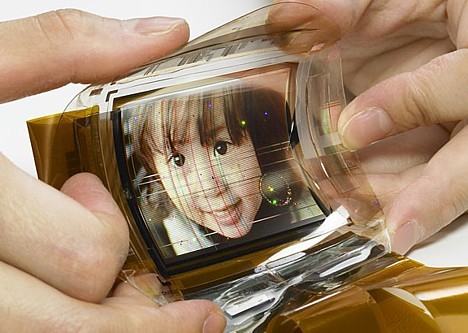Flat screens and tall people

Sony has announced a flat, 2.5" (diagnoal), 120 x 160 pixel display so flexible that it can roll up into a 1" cylinder. It weighs in at a mere 1.5 grams. (Why do they always give dimensions in Imperial units and weight in Metric? No clue. I'll just rebalance things by pointing out that it's 6.35 cm and 0.053 oz.)
What could you do with a lightweight, low-power, flexible display? Well, you could make a cell phone with a 6" (say) by as-long-as-you-want screen--leave it rolled up as you talk, but when you need to review that spreadsheet, just deploy the display from the phone like a window shade. A typical PC screen these days is 1280 x 1024 pixels--your phone could easily have (say) 600 x 4000 and up--in principle, the only limit to its width is how widely you can spread your arms--and the more pixels you have, of course, the less you'll have to scroll, and the more effective you'll be professionally. (Tall people make more money than short people, on average, and tall men enjoy a romantic advantage as well--this could be yet another leg up they'd have.) Add touch screen capabilities and the possibilities multiply--your phone could become, in effect, a much-more-than-full-size tablet PC.
I recently saw the CEO of Motorola discussing the future of mobile devices. He travels sans laptop--everything he needs to do, he can do with his (presumably Motorola) smart phone. At Accenture Technology Labs, we believe that Enterprise Mobility is one of eight trends (we always capitalize our trends) that'll drive computing over the next five years. We're already seeing it in the mass deployment of phone-based email, IM, and personal productivity tools. In the future, we expect to see the advent of Just in Time (JIT) learning, field service enablement, customer relationship management (CRM) and other mission critical applications--not as replacements for their stationary cousins, but as extensions of them. Ultimately, they'll serve to support truly end-to-end business processes.
The point of all this is that flexible displays could change the take-up rate. A cell phone's screen is painfully small for most applications, so implementing enterprise apps will require extreme cleverness. If phones get flexible gigantic displays, however, we may get a BOB-W (Best of Both Worlds) solution: the phone's mobility, location-awareness and personal context combined with touch-sensitivity and more pixels than we'll know what to do with. Good news. Almost enough to make up for the fact that (once again) the tall people will have it better than the rest of us.
